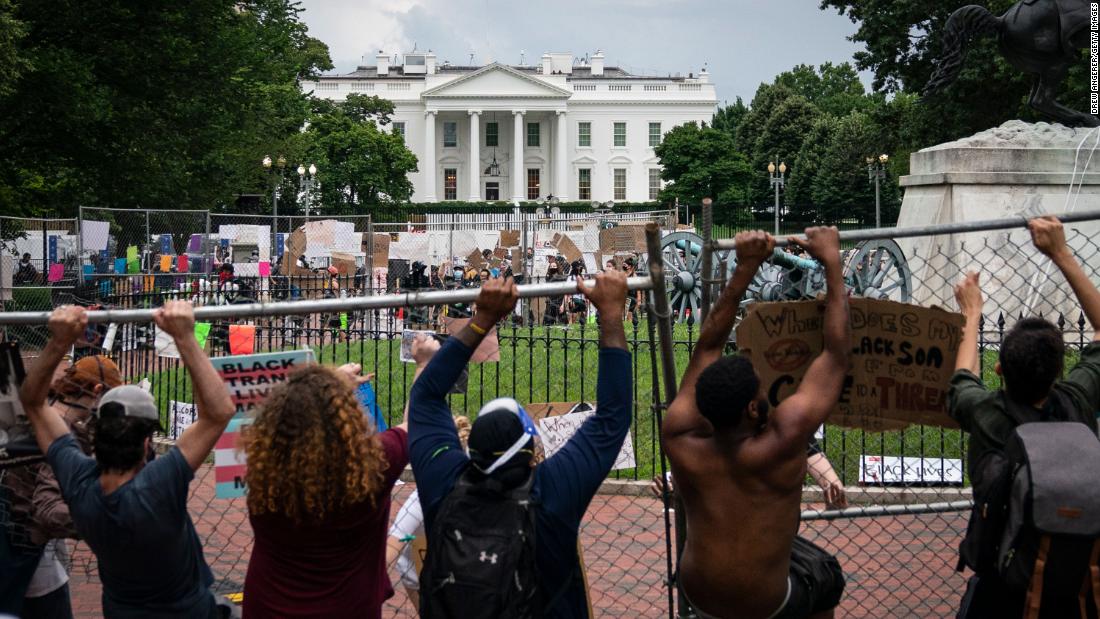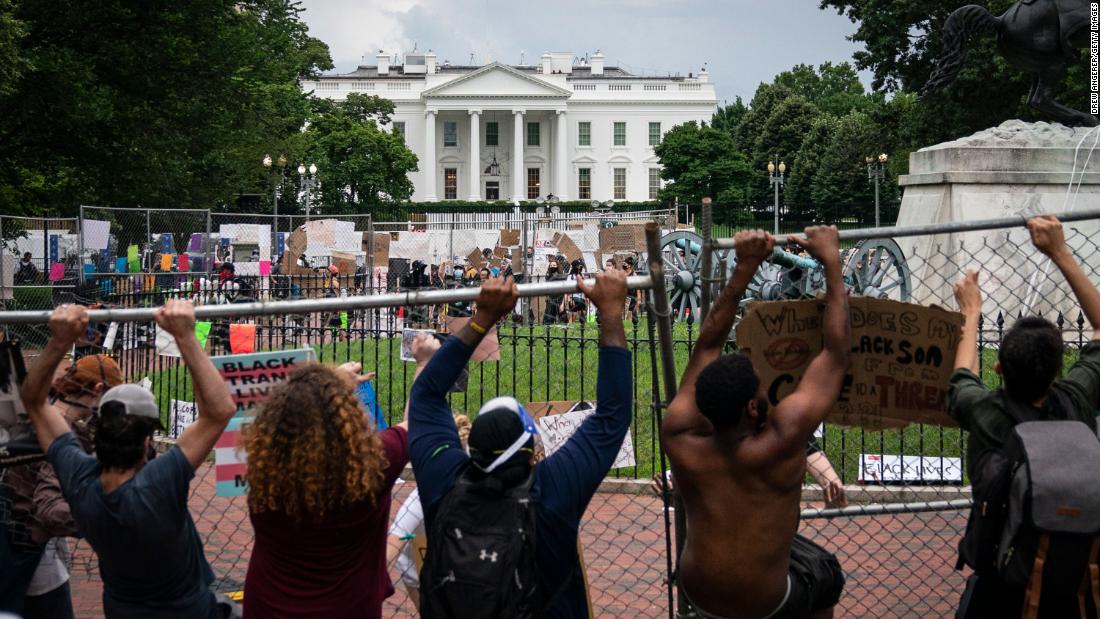[ad_1]

From the corporate embrace of Black Lives Matter to actions by NASCAR — of all the sports leagues — and Premier League Soccer, it’s a movement that has taken hold and gained public acceptance despite Trump’s attempts to make it appear violent and radical.
Will pockets of violence be perceived as riots or rallies? A test of the movement will be figuring out whether that acceptance is fragile or firm.
It’s not exactly connect-the-dots to see what Trump is doing when he tries to emulate Nixon as a “law and order” president.
Though protests that channel the anger at institutional racism have continued in a mostly peaceful way, there are pockets of violence that could threaten the larger public perception.
- A standoff between police and protesters trying to topple a statue of Andrew Jackson — Trump’s favorite President and a noted racist — across from the White House on Monday led to members of the media being evacuated, wrongly, from the White House grounds and gave Trump a foothold to complain about “looters” and promise jail time for anyone defacing government property.
- Shootings, a death and vandalism in what’s known as the Capitol Hill Autonomous Zone in Seattle have made it hard to argue there should be no police. Seattle’s mayor said Tuesday that the city will reclaim the autonomous zone
White House press secretary Kayleigh McEnany said earlier this month that the President is opposed to the movement.
“All black lives matter, but in terms of the movement Black Lives Matter, they define themselves as ‘defund the police,’ and that’s something this President stands against.
How the protest movement evolves after this initial period — and whether it can remain peaceful — will be key to guarding against Trump’s taunts.
What’s next in Washington? Bickering — Democrats in the House want a federal ban on chokeholds. Republicans in the Senate don’t want to institute a federal ban; they just want to encourage police departments not to use chokeholds.
How #BlackLivesMatter keeps its momentum
I reached out to Professor Wasow to ask a little bit about his research, how it applies to today and whether protesters can sustain their momentum.
ZBW: What’s the fine line between protest ’64 and protest ’68?
OW: One big difference between the civil rights protests prior to 1964 versus 1968 is the relative proportion of protester-initiated violence. In the early part of the 1960s, direct action by protesters was largely nonviolent and often met with brutal state repression.
Despite widespread discrimination against African Americans, my research found that the early 1960s wave of black-led civil disobedience was able to successfully influence media to focus on “civil rights.” My research also found that as media coverage highlighted “civil rights,” public opinion and congressional legislation followed. In the mid-to-late 1960s, protest tactics shifted in many demonstrations and state violence was often met by protester-initiated violence. Media coverage of these events was much more likely to emphasize issues of “crime” and “riots.” Once again, media coverage helped move public opinion and politics but this time towards a focus on “law and order.”
ZBW: What should BLM protesters do to keep the public on their side?
OW: Evidence from the 1960s suggests that a particularly powerful way for protesters to command public attention and generate sympathetic coverage is to engage in direct action that, as Rep. John Lewis described then, “dramatizes injustice.”
These images are a modern version of “dramatizing injustice” in that they make visible and help justify the concerns of the larger movement to transform policing in America. The challenge with this method of protest is that activists risk trauma, injury and even death. Consequently, despite the effectiveness of this approach, it is very hard to sustain.
ZW: Separately, I’d be interested to know if you think corporate America has ever been as engaged in or supportive of a protest movement as it is trying to appear today?
OW: In the 1960s, national corporations typically only supported desegregation under enormous pressure from boycotts. In the current wave of #BlackLivesMatter protests, there appears to be more widespread corporate support even without targeted pressure from activists.
At the same time, much of the current corporate support for #BlackLivesMatter appears to be more symbolic than substantive and only time will tell whether more significant change is truly on the horizon.
Finally, much of the change that is necessary to improve the material well-being of African Americans is policy change, not shifts in corporate policy. So, even if corporations make big improvements in policies like hiring, that is unlikely to change the profound inequalities in policing, education and housing that currently limit the life chances of Black Americans.
ZW: Congress is debating very police-specific policy changes, such as a ban on chokeholds. What are some of the profound education and housing changes you’d suggest lawmakers also look at?
OW: One of the primary ways inequality works in America is through housing segregation. The quality of schools, parks and other publicly provided goods is heavily influenced by your ZIP code. While explicit forms of racial discrimination in housing are now illegal, following passage of the Fair Housing Act many communities in United States, both liberal and conservative, enacted forms of economic zoning that make it hard for low income people to move to areas of high opportunity. Many cities now require between 75% and 80% of the housing stock to be single family homes. The legal prohibition on even moderate density options like small apartment buildings drives up the cost of housing, increases dependence on cars, is bad for the environment and contributes to the kinds of class and racial segregation that limit upward mobility.
Coronavirus latest
He wasn’t kidding. He actually believes it. Trump was asked if he was really kidding that the US is doing too many tests.
So he really does believe, no kidding and no irony, that we should slow testing because “by having more tests, we have more cases.”
Surge of infections — Dr. Anthony Fauci talked about the rise in US infections on Capitol Hill and said, “It really is a mixed bag.”
“You have a very large country, very heterogeneous, major differences — for example, between the New York metropolitan area and Casper, Wyoming,” but it’s clear, Fauci said, “we’ve been hit badly.”
He gave advice on addressing these increases in cases.
“The way you address that — and I’ve said this over and over again — is you have to have the manpower, the system, the testing to identify, isolate and contact trace in an effective way so that when you see those increases, you can understand where they are coming from, and you can do something about them,” Fauci said.
He added, “Right now the next couple of weeks are going to be critical in our ability to address those surgings that we’re seeing in Florida, in Texas and in Arizona.”
Test, test, test — Trump says there are too many coronavirus tests. But most other folks seem to agree that widespread testing is the key to finding and isolating the virus instead of allowing it to spread.
Where are we on a Covid-19 vaccine?
A vaccine is the key to getting past Covid-19, and the US government has invested more than $3 billion, funding research into six different possible vaccines. $700 million of that is being reserved to help companies that will ultimately produce a vaccine.
Note: In the end, some of these may work and some might not. We’ll know only after large-scale clinical trials with tens of thousands of people.
$1.2 billion to AstraZeneca
Status: The University of Oxford, which is partnering with AstraZeneca, recently began large-scale, Phase 3 human clinical trials in England on this vaccine. AstraZeneca plans to begin Phase 3 trials in August. Such trials are the last step before a vaccine maker seeks approval from regulators.
$456 million to Johnson & Johnson
Status: J&J expects to start Phase 3 clinical trials in September.
History: Other vaccines have used this adenovirus technique, and while those vaccines have been studied in clinical trials, they’ve never been approved and put on the market.
$430 million to Moderna
Status: Moderna plans to start Phase 3 trials in July.
History: Other vaccines have used (the technique being used by Moderna) and while those vaccines have been studied in clinical trials, they’ve never been approved and put on the market.
$60 million to Novavax
Status: Novavax has not yet started Phase 3 trials.
$38 million to Merck
Status: Merck has not yet started human clinical trials.
History: This same technology was used to make an Ebola vaccine called ERVEBO that was approved by the FDA in 2019.
$30 million to Sanofi
Status: Sanofi expects to start clinical trials between October and December.
History: This same technology using a baculovirus was used to make a flu vaccine called Flublok, which was approved by the FDA in 2013.
[ad_2]
Source link

